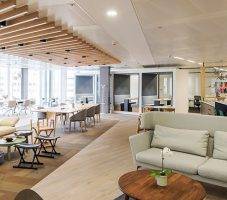August 6, 2016
Connectivity creep + Appeal of open plan + Tech and real estate 0
 In this week’s Newsletter; Antony Slumbers looks at the impact of technology on corporate real estate; and Mark Eltringham describes a precursor of the scientific management theories of Frederick Taylor that continues to influence open plan design. We report on the impact Smart Cities can have on energy management; why people are opting for a ‘digital detox’; and how workers are turning their backs on the traditional 9-5 day. A new report says CRE must deliver greater value in a dynamic business environment; one in five workers miss sleep over work worries; and despite hitting an all time high, Brexit uncertainty still permeates the UK’s commercial property market. We also list the seven workplace stories you should read this week. Download our new Briefing, produced in partnership with Boss Design on the link between culture and workplace strategy and design; visit our new events page, follow us on Twitter and join our LinkedIn Group to discuss these and other stories.
In this week’s Newsletter; Antony Slumbers looks at the impact of technology on corporate real estate; and Mark Eltringham describes a precursor of the scientific management theories of Frederick Taylor that continues to influence open plan design. We report on the impact Smart Cities can have on energy management; why people are opting for a ‘digital detox’; and how workers are turning their backs on the traditional 9-5 day. A new report says CRE must deliver greater value in a dynamic business environment; one in five workers miss sleep over work worries; and despite hitting an all time high, Brexit uncertainty still permeates the UK’s commercial property market. We also list the seven workplace stories you should read this week. Download our new Briefing, produced in partnership with Boss Design on the link between culture and workplace strategy and design; visit our new events page, follow us on Twitter and join our LinkedIn Group to discuss these and other stories.









 SMEs that neglect to offer flexible work options may find their employees decide to switch to somewhere that does, according to a survey from
SMEs that neglect to offer flexible work options may find their employees decide to switch to somewhere that does, according to a survey from 
 UK growth had already eased from around 3 percent in 2014 to around 2 percent before the EU referendum due primarily to slower global growth, but the Brexit vote to leave the EU is likely to lead to a significant further slowdown. UK GDP growth is forecast to decelerate to around 1.6 percent in 2016 and 0.6 percent in 2017 according to
UK growth had already eased from around 3 percent in 2014 to around 2 percent before the EU referendum due primarily to slower global growth, but the Brexit vote to leave the EU is likely to lead to a significant further slowdown. UK GDP growth is forecast to decelerate to around 1.6 percent in 2016 and 0.6 percent in 2017 according to 
 Global law firm Osborne Clarke has released its fourth
Global law firm Osborne Clarke has released its fourth 
 A coalition of twenty major European telecommunications firms has come together to drive the rapid creation of a continent wide 5G network and warn national Governments and the EU of the dangers of over-regulation. The seven page document entitled the
A coalition of twenty major European telecommunications firms has come together to drive the rapid creation of a continent wide 5G network and warn national Governments and the EU of the dangers of over-regulation. The seven page document entitled the 
















August 8, 2016
Universal basic income is an idea whose time has come at last 0
by Mark Eltringham • Comment, Flexible working, Technology, Wellbeing
(more…)